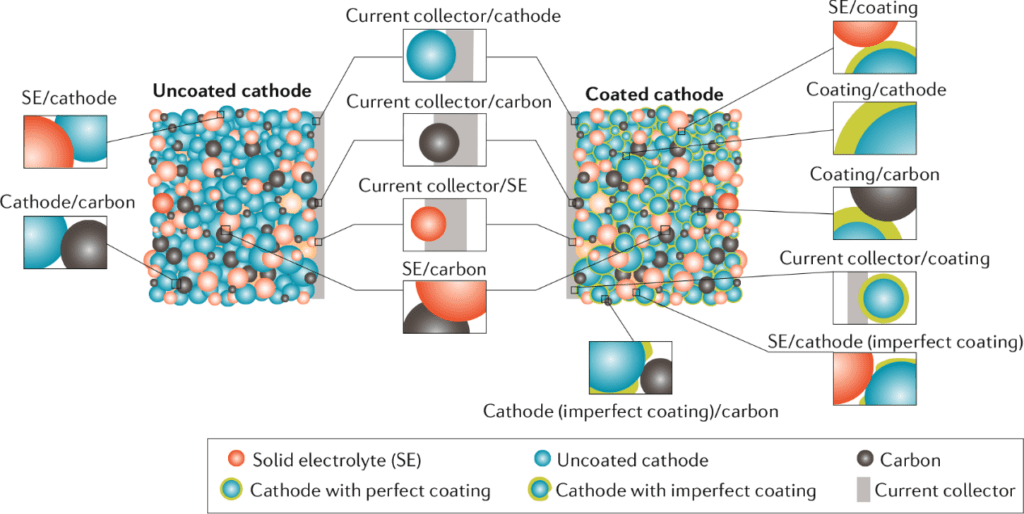Solid-state batteries have emerged as a promising solution to address the limitations of current lithium-ion batteries used in electric vehicles (EVs). These advanced batteries, highlighted in a study published in Nature Communications, offer a range of advantages including higher energy density, enhanced safety, and potentially faster charging times.

#post_seo_title
Lithium-ion batteries, widely used in EVs for their decent energy-to-weight ratio and charging flexibility, have reached their limits in terms of energy density and safety due to their flammable nature. In contrast, solid-state batteries utilize solid electrolytes instead of flammable liquid electrolytes, significantly reducing the risk of fires and enabling them to withstand greater temperature fluctuations.
One of the main benefits of solid-state batteries is their higher energy density, meaning they can store more energy in relation to their weight and volume. This increased energy density can maximize the range of electric vehicles, allowing for longer journeys without the need for frequent recharging.
Enhanced safety is another key advantage of solid-state batteries. By eliminating the flammable liquid electrolyte, the risk of accidents and fires is significantly reduced. This makes solid-state batteries a much safer option for electric vehicles, addressing a major concern for consumers.
Charging speed is another area where solid-state batteries excel. Researchers are actively working to improve the charging efficiency of these batteries, which could potentially reduce the time required to charge EVs and other electronic devices. Faster charging times would greatly enhance the convenience and practicality of electric vehicles, making them more attractive to consumers.
In addition to their performance benefits, solid-state batteries also contribute to the sustainability aspect of electric vehicles. These batteries are easier to recycle compared to lithium-ion batteries, offering a more environmentally friendly solution for the growing number of EVs on the road.
However, solid-state batteries do face some challenges. The current cost of manufacturing these batteries is relatively high, limiting their use to small-scale applications such as pacemakers. Additionally, the formation of lithium dendrites poses a safety concern, as these needle-like structures can potentially cause short-circuits in the battery. The study mentioned in the article provides new insights into preventing dendrite formation, addressing this safety issue.
Transferring electrical charges through solids, as required by solid-state batteries, presents a technical challenge that needs to be overcome for these batteries to reach their full potential.
Despite these challenges, manufacturers are actively working on developing electric vehicles equipped with solid-state batteries. Some companies even anticipate bringing these vehicles to market as early as 2024. As production scales up, the cost of solid-state batteries is expected to decrease, making them a viable option for the next generation of electric vehicles.
In conclusion, solid-state batteries have the potential to overcome the limitations of current lithium-ion batteries, making them the future of electric vehicles. With higher energy density, improved safety, and potentially faster charging times, these batteries could drive widespread adoption of electric cars. However, addressing the challenges associated with cost and charge transfer is crucial. The findings of the study conducted by Daniel Rettenwander and his team represent a significant step towards achieving this goal.
[Definitions]
– Solid-state batteries: These batteries utilize solid electrolytes instead of flammable liquid electrolytes, offering higher energy density, improved safety, and potentially faster charging.
– Lithium-ion batteries: The current batteries commonly used in electric vehicles, known for their decent energy-to-weight ratio and charging flexibility.
– Energy density: The amount of energy stored in a given volume or weight.
– Flammable: Easily capable of catching fire.
– Dendrite formation: The growth of needle-like structures called lithium dendrites, which can cause short-circuits in batteries.
– Charge transfer: The process of transferring electrical charges from one material or component to another.
[Sources]
– Daniel Rettenwander et al., Nature Communications
– Image: Unsplash


